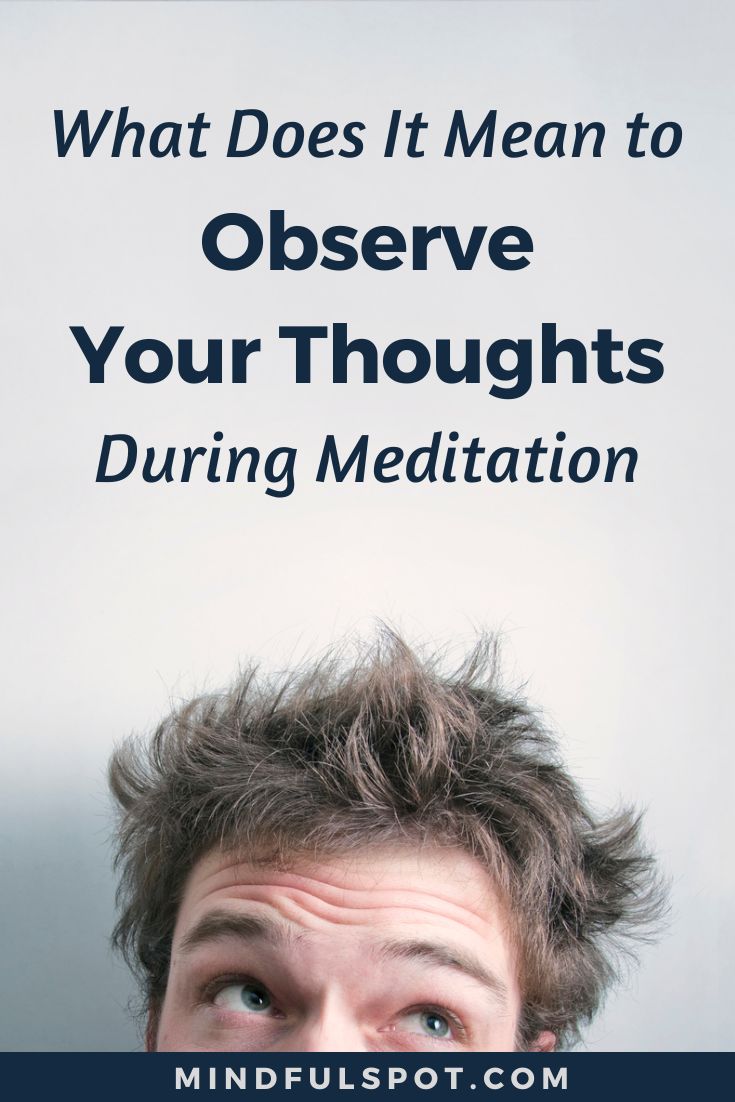“Just observe your thoughts,” they say.
But aren’t you already observing your thoughts by thinking about them? This is a great point! The internet abounds with advice that can be confusing for beginners in meditation.
For example, you might’ve also heard someone say that you should let your thoughts come and go. It can sound confusing, and many beginners (including myself when I first learned how to meditate) struggle to understand this concept.
I hope this article sheds some light and offers ideas to improve your meditation practice.
What Does Observing Thoughts Mean in Meditation?
The world of meditation can be full of confusing advice, especially for beginners. You might hear someone say, “Become a witness of your thoughts without engaging with them.”
Here’s the key: Observing your thoughts in meditation isn’t about analyzing them, but rather acknowledging their presence and letting them go without judgment.

FREE Self-Test: How Spiritual Are You?
5 Examples of Observing Your Thoughts During Meditation
Here are five examples of what it means to observe your thoughts in meditation.
1. “I don’t like this!”
Our capitalist culture has trained us to be busy. If you’re not doing something to “make money,” “reach your goals,” or “realize your full potential,” you’re wasting your life (this, of course, is blatant lie). That’s why when you first sit still, your mind might rebel with judgments like, “I don’t like this!” At that moment, label it as “thinking,” gently let it go, and return to your breath.
2. “How do I stop thinking?”
Meditation isn’t about stopping thoughts, it’s about observing them without judgment. If you find yourself ruminating on past mistakes, worrying about future events, and wondering “How do I stop thinking?” simply label it as “thinking” and return to your breath.
3. “Why do I feel so uncomfortable?”
Meditation isn’t always blissful relaxation. Aim for a balance between alertness and ease. Choose a comfortable posture and be mindful of any physical discomfort. If you find yourself asking, “Why do I feel so uncomfortable?” label it as “thinking” and return to your breath.
4. “Why is it taking so long?”
Time perception can warp during meditation. A minute can feel like an eternity. Don’t get discouraged! If impatience arises and you wonder, “Why is it taking so long?” simply label it as “thinking” and return to your breath.
5. “Am I doing this the right way?”
Self-doubt is a natural part of the meditation journey. If you find yourself questioning your technique and asking yourself, “Am I doing this the right way?” label it as “thinking” and return to your breath.
Is It Normal to Have Thoughts During Meditation?
Yes, it’s a common experience for everyone. If you’ve been struggling with distracting thoughts during meditation, here are three common reasons:
1. Early Stages of Meditation Practice
Our minds are naturally busy with analyzing, planning, and predicting. It’s no surprise your mind goes into overdrive when you try to sit still, even for a short time.
2. Stressful Life Situations
Recent stressful events like a betrayal or breakup can significantly impact your well-being and occupy your mind. Thoughts about these events might interfere with your concentration during meditation.
3. Using the Wrong Meditation Techniques
Using the wrong technique for your goals can lead to frustration and distracting thoughts. For example, breathing meditation can help with restlessness and agitation, while lovingkindness meditation helps with anger and resentment. Choose a technique suited to address what you’re trying to achieve.
3 Simple Ways to Minimize Distracting Thoughts During Meditation
Here are three simple ways you can minimize distracting thoughts when meditating.
1. Acknowledge Your Most Pressing Issue
From personal experience, acknowledging my most pressing issue before meditation helps prevent me from dwelling on it. Next time you meditate, acknowledge any current stress and tell yourself you’ll do your best to keep your mind clear.
2. Choose a Comfortable Meditation Posture
Trying to meditate in an uncomfortable position, like a lotus pose, can lead to a negative experience and fill your mind with distracting thoughts. We have an article titled “3 Relaxing Meditation Postures for Beginners” that can help.
3. Practice Body Awareness Meditation
Many beginners miss this. Being aware of your body is a powerful tool to quiet a wandering mind. For more information, read our article titled “How to Practice Body Awareness Meditation for Beginners.”
In Conclusion
Remember, meditation is a practice, not a destination. With consistent effort and a gentle approach towards your thoughts, you’ll cultivate a more mindful and peaceful state of being.
Complement with Buddhist Meditation: Tranquility, Imagination and Insight by Kamalashila. And if you want to learn beginner-friendly meditation techniques, be sure to check out our articles on how to practice body awareness meditation, how to practice breathing meditation, and how to practice lovingkindness meditation.

FREE mindfulness resources for stress relief
I’m a freelance writer and mindfulness advocate behind this blog. I started my meditation practice in 2014, and in 2017 I launched this website to share what I learn with others. Here are the three things you can do here:
1. Schedule a free consult if you want to learn Buddhist meditation.
2. Download free mindfulness resources for stress relief
3. Join Patreon for exclusive content and community meetings.








